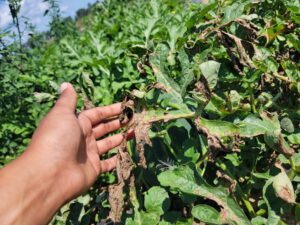Earlier this year, Rely® 280 was registered for use in transplanted cantaloupe, cucumber, pepper, summer squash, tomato, and watermelon with a supplemental label. The registration allows for the use of Rely® 280 for pre-plant burndown and post-directed applications to row middles. Previously, postemergence burndown and row middle options were limited to glyphosate (Roundup®), carfentrazone (Aim®), paraquat (Gramoxone®), and pelargonic acid (Scythe®). Before this registered use, the plant-back restriction for these crops was 180 days following a Rely® 280 application, making its use impractical.
About the herbicide
The active ingredient in Rely® 280 is glufosinate. Although the name sounds similar, glufosinate is not the same as glyphosate (commonly known as Roundup®). Unlike glyphosate, glufosinate is mostly a contact herbicide with little movement through plants. However, just like glyphosate, glufosinate is not selective, and you must use caution to avoid spraying or drifting onto your crop or other desirable plants. Glufosinate is a Group 10 herbicide and should help to manage some weeds that are resistant to glyphosate (a Group 9 herbicide). Sprayed plants typically yellow or wilt 3 to 5 days after treatment and brown after 7 to 10 days. Symptoms from an intentionally sprayed watermelon plant are in Figure 1.

Figure 1. Injury to watermelon foliage following a reduced rate application of glufosinate at the Pinney Purdue Agriculture Center in 2022 (Photo by Jeanine Arana).
Making row middle applications
Apply 29 to 62 fluid ounces per treated acre. Up to two row middle applications can be made, but do not exceed a total of 62 fluid ounces per acre per season. Allow at least 14 days between applications. Apply in a hooded sprayer. If a hooded sprayer is not available, precision-directed spray application equipment can be used as long as the nozzles are adjusted to prevent spray drift from contacting the crop foliage and/or fruit. For crops grown on flat ground (not raised beds), do not spray within 6 inches of the crop.
Pre-harvest intervals
Allow at least 14 days between the last application and harvest for cucumber and summer squash and 30 days for cantaloupe, pepper, tomato and watermelon.
Tips for success
-For the best herbicide activity, apply on warm, sunny days with high humidity.
-If hard water is used, include ammonium sulfate to condition the spray solution.
-Target weeds less than 4 inches tall or wide. Smaller weeds require a lower use rate for effective control. When weeds are larger, they can have an overlapping canopy which reduces spray coverage resulting in reduced weed control. Some larger weeds and perennial weeds may regrow following application.
-Allow 6 hours of rain-free weather following application.
-Rely® 280 can foam during agitation. To combat this, you can add an anti-foaming agent.
Where can I find the supplemental label?
The label is so new that it has not yet been published on many of the pesticide label databases. However, the approved registration is available on the Office of Indiana State Chemist’s Special Registrations webpage: Pesticide Section – Pesticide Products & Devices. There are separate supplemental labels for the cucurbit crops (cantaloupe, cucumber, summer squash, and watermelon) and fruiting vegetables (pepper and tomato). This link also includes supplemental labels for figs, hops, and avocados. Information for these additional registered uses was recently added to the online Midwest Vegetable Guide database available at Midwest Vegetable Production Guide (mwveguide.org).